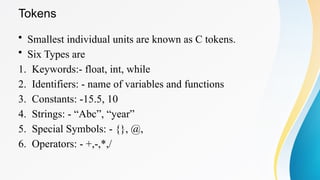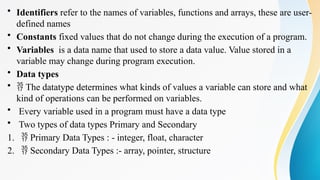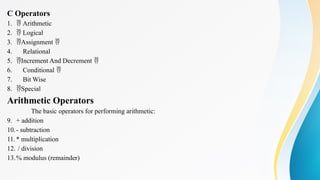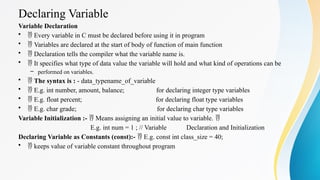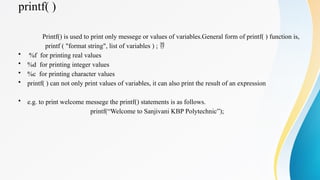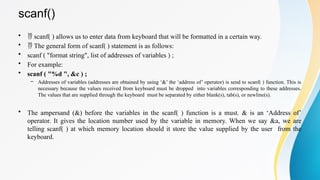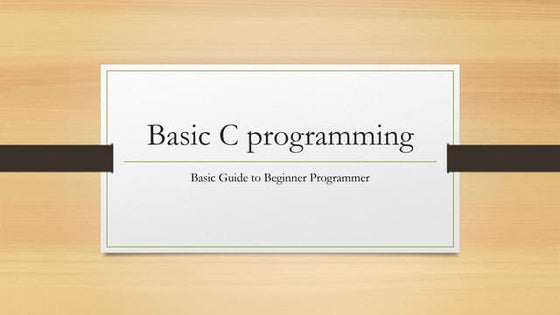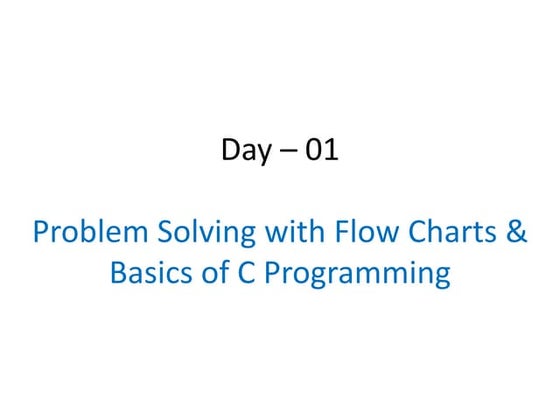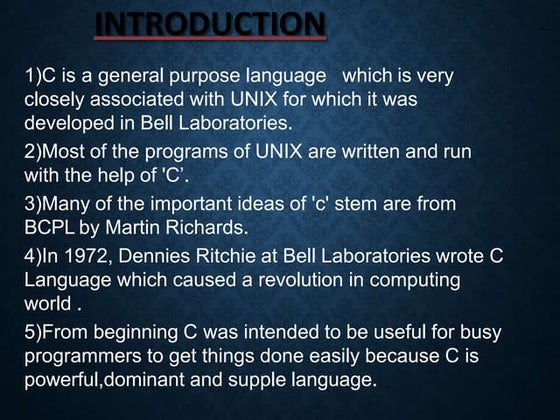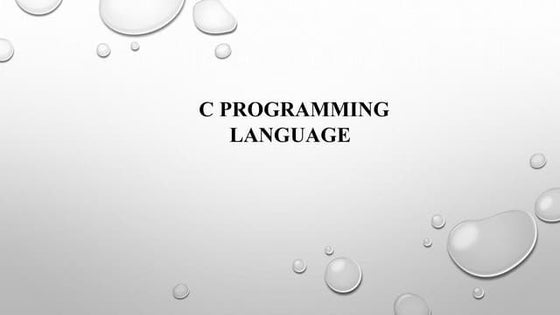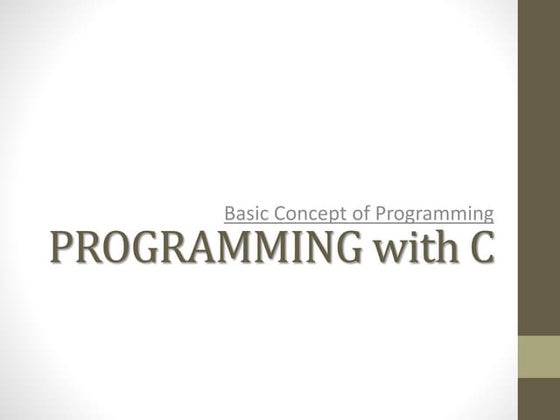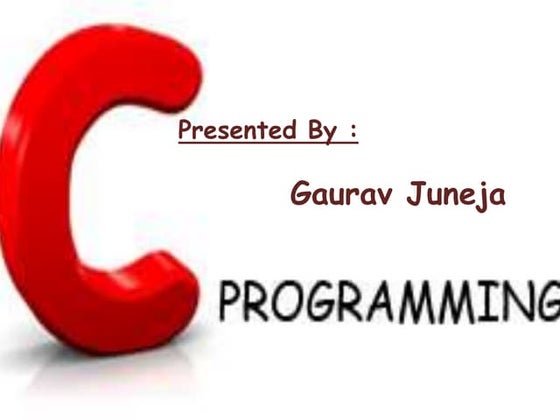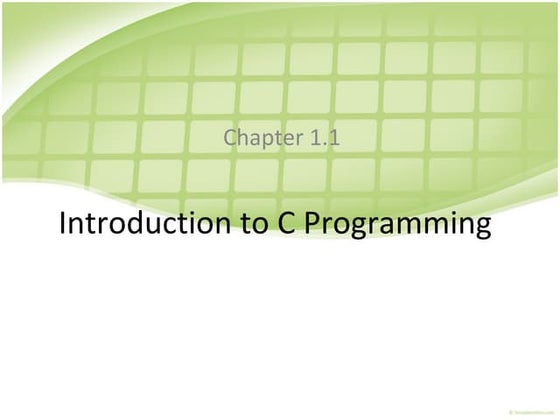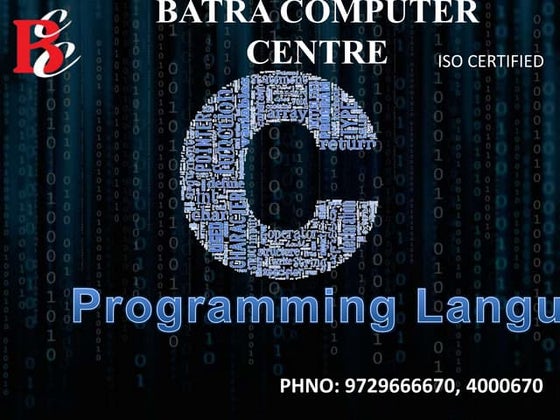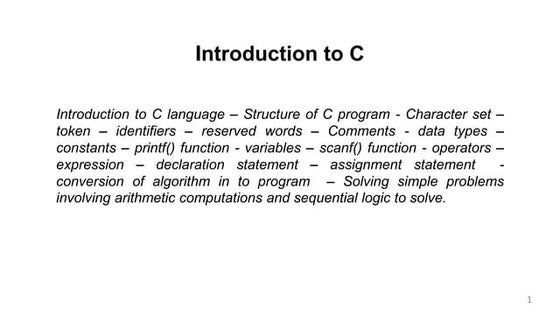Unit No 2.pptx Basic s of C Programming
- 1. Unit No-2 Basics of C Programming 2.1 Introduction to C. 2.2 Data Concepts. 2.3 Basic Input Output.
- 2. 2.1 Introduction to C ŌĆó History of C. ŌĆó General Structure of C program. ŌĆó Header files. ŌĆó Main Function.
- 3. History of C Language ŌĆó ’éĘ Developed at AT&TŌĆÖs Bell Laboratories of USA in 1972 ŌĆó ’éĘ Designed and written by a man named Dennis Ritchie ŌĆó ’éĘ Most of its principles and ideas were taken from the earlier language B, BCPL and CPL ŌĆó ’éĘ Languages before C are PL/I, ALGOL, FORTRAN, Pascal, APL, B
- 5. Importance of C ŌĆó ’éĘ General purpose language but normally used for system programming ŌĆó ’éĘ Robust due to rich set of built in functions and operaters for writing complex program ŌĆó ’éĘ C is highly portable i.e. platform independent ŌĆó ’éĘ Can add our own functions to C library
- 6. Structure of C program. ŌĆó A C program is divided into different sections. There are six main sections to a basic c program. The six sections are, ŌĆó Documentation ŌĆó Link ŌĆó Definition ŌĆó Global Declarations ŌĆó Main functions ŌĆó Subprograms
- 7. Documentation Section ŌĆó The documentation section is the part of the program where the programmer gives the details associated with the program. He usually gives the name of the program, the details of the author and other details like the time of coding and description. It gives anyone reading the code the overview of the code. ŌĆó Example /* File Name: Helloworld.c Author: om Sai date: 09/08/2021 */
- 8. Link Section ŌĆó This part of the code is used to declare all the header files that will be used in the program. This leads to the compiler being told to link the header files to the system libraries. ŌĆó Example ŌĆó #include<stdio.h> Definition Section ŌĆó In this section, we define different constants. The keyword define is used in this part. ŌĆó #define PI=3.14 Global Declaration Section ŌĆó This part of the code is the part where the global variables are declared. All the global variable used are declared in this part. The user-defined functions are also declared in this part of the code. float b; int a=7;
- 9. Main Function Section Every C-programs needs to have the main function. Each main function contains 2 parts. A declaration part and an Execution part. The declaration part is the part where all the variables are declared. The execution part begins with the curly brackets and ends with the curly close bracket. Both the declaration and execution part are inside the curly braces. int main(void) { int a=10; printf(" %d", a); return 0; } Sub Program Section All the user-defined functions are defined in this section of the program. int add(int a, int b) { return a+b; }
- 10. Header Files In C language, header files contain the set of predefined standard library functions. The ŌĆ£#includeŌĆØ preprocessing directive is used to include the header files with ŌĆ£.hŌĆØ extension in the program. ŌĆó Here is the table that displays some of the header files in C language, Header Files Description 1. stdio.h Input/Output functions 2. conio.h Console Input/Output functions 3. stdlib.h General utility functions 4. math.h Mathematics functions 5. string.h String functions 6. ctype.h Character handling functions 7. time.h Date and time functions 8. float.h Limits of float types 9. limits.h Size of basic types 10.wctype.h Functions to determine the type contained in wide character data.
- 11. 2.2 Data Concepts ŌĆó Character Set ŌĆó Tokens ŌĆó Keywords ŌĆó Identifires ŌĆó Variables ŌĆó Constants ŌĆó Datatypes ŌĆó C Operators ŌĆó Arithmetic Operators
- 12. C CharacterSet ŌĆó A character denotes any alphabet, digit or special symbol used to represent information. ŌĆó Alphabets A,B,ŌĆ”..,Y,Z a,b,ŌĆ”ŌĆ”,y,z ŌĆó Digits 0,1,2, 3,4,5,6, 7,8,9 ŌĆó Specialsymbols ~ŌĆś!@#%^&*()_-+=| {} [ ]:; "'<>,.?/
- 13. Tokens ŌĆó Smallest individual units are known as C tokens. ŌĆó Six Types are 1. Keywords:- float, int, while 2. Identifiers: - name of variables and functions 3. Constants: -15.5, 10 4. Strings: - ŌĆ£AbcŌĆØ, ŌĆ£yearŌĆØ 5. Special Symbols: - {}, @, 6. Operators: - +,-,*,/
- 15. Keywords ŌĆó Keywords are the words whose meaning has already been explained to the C compiler. ŌĆó The following names are reserved by the C language. Their meaning is already defined, and they cannot be re- defined.
- 16. ŌĆó Identifiers refer to the names of variables, functions and arrays, these are user- defined names ŌĆó Constants fixed values that do not change during the execution of a program. ŌĆó Variables is a data name that used to store a data value. Value stored in a variable may change during program execution. ŌĆó Data types ŌĆó ’éĘ The datatype determines what kinds of values a variable can store and what kind of operations can be performed on variables. ŌĆó Every variable used in a program must have a data type ŌĆó Two types of data types Primary and Secondary 1. ’éĘ Primary Data Types : - integer, float, character 2. ’éĘ Secondary Data Types :- array, pointer, structure
- 18. C Operators 1. ’éĘ Arithmetic 2. ’éĘ Logical 3. ’éĘAssignment ’éĘ 4. Relational 5. ’éĘIncrement And Decrement ’éĘ 6. Conditional ’éĘ 7. Bit Wise 8. ’éĘSpecial Arithmetic Operators The basic operators for performing arithmetic: 9. + addition 10.- subtraction 11.* multiplication 12. / division 13.% modulus (remainder)
- 19. Declaring Variable Variable Declaration ŌĆó ’éĘ Every variable in C must be declared before using it in program ŌĆó ’éĘ Variables are declared at the start of body of function of main function ŌĆó ’éĘ Declaration tells the compiler what the variable name is. ŌĆó ’éĘ It specifies what type of data value the variable will hold and what kind of operations can be ŌĆō performed on variables. ŌĆó ’éĘ The syntax is : - data_typename_of_variable ŌĆó ’éĘ E.g. int number, amount, balance; for declaring integer type variables ŌĆó ’éĘ E.g. float percent; for declaring float type variables ŌĆó ’éĘ E.g. char grade; for declaring char type variables Variable Initialization :- Means assigning an initial value to variable. ’éĘ ’éĘ E.g. int num = 1 ; // Variable Declaration and Initialization Declaring Variable as Constants (const):- E.g. const int class_size = 40; ’éĘ ŌĆó ’éĘ keeps value of variable constant throughout program
- 20. 2.3 Basic Input Output. ŌĆó Input and Output Statements using printf() and scanf().
- 21. printf( ) Printf() is used to print only messege or values of variables.General form of printf( ) function is, printf ( "format string", list of variables ) ; ’éĘ ŌĆó %f for printing real values ŌĆó %d for printing integer values ŌĆó %c for printing character values ŌĆó printf( ) can not only print values of variables, it can also print the result of an expression ŌĆó e.g. to print welcome messege the printf() statements is as follows. printf(ŌĆ£Welcome to Sanjivani KBP PolytechnicŌĆØ);
- 22. scanf() ŌĆó ’éĘ scanf( ) allows us to enter data from keyboard that will be formatted in a certain way. ŌĆó ’éĘ The general form of scanf( ) statement is as follows: ŌĆó scanf ( "format string", list of addresses of variables ) ; ŌĆó For example: ŌĆó scanf ( "%d ", &c ) ; ŌĆō Addresses of variables (addresses are obtained by using ŌĆś&ŌĆÖ the ŌĆśaddress ofŌĆÖ operator) is send to scanf( ) function. This is necessary because the values received from keyboard must be dropped into variables corresponding to these addresses. The values that are supplied through the keyboard must be separated by either blank(s), tab(s), or newline(s). ŌĆó The ampersand (&) before the variables in the scanf( ) function is a must. & is an ŌĆśAddress ofŌĆÖ operator. It gives the location number used by the variable in memory. When we say &a, we are telling scanf( ) at which memory location should it store the value supplied by the user from the keyboard.
- 23. Escape Sequences

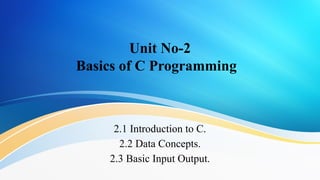




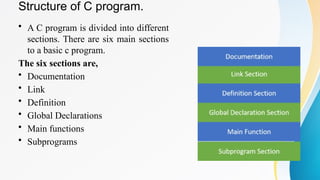


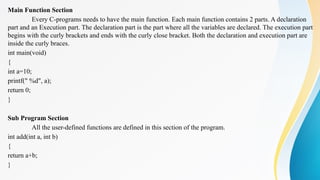

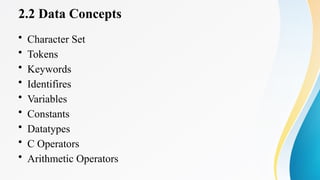
![C CharacterSet
ŌĆó A character denotes any alphabet, digit or special symbol used
to represent information.
ŌĆó Alphabets A,B,ŌĆ”..,Y,Z a,b,ŌĆ”ŌĆ”,y,z
ŌĆó Digits 0,1,2, 3,4,5,6, 7,8,9
ŌĆó Specialsymbols ~ŌĆś!@#%^&*()_-+=| {} [ ]:; "'<>,.?/](https://image.slidesharecdn.com/unitno2-241210090304-95d0b396/85/Unit-No-2-pptx-Basic-s-of-C-Programming-12-320.jpg)
